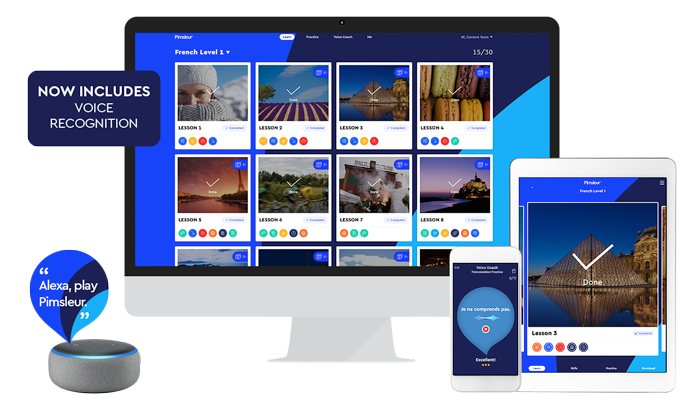French vs Spanish: Which Is More Useful To Learn?
French vs Spanish: Which Is More Useful To Learn?
Photo Credit: Argus/Adobe Stock
Affiliate Disclaimer: This post contains affiliate links. This means I will earn an affiliate commission if you click and/or make a purchase through the link (at no extra cost to you). And of course, I only recommend products I’ve used from companies I completely trust and love. For more information please see my disclosure.
French vs Spanish: Which Language Is Right For You?
Are you thinking about adding a new language to your skill set, but can't decide between French and Spanish? Choosing the right foreign language can feel like a tough decision when both options seem equally tempting.
Maybe you're dreaming of strolling along the Seine or envisioning yourself dancing in the heart of Madrid – either way, knowing which language aligns best with your goals and interests is key.
Here’s some good news: both French and Spanish are romance languages, packed with Latin roots and many shared words that might already be familiar!
This article will guide you through the maze of similarities and differences between these two beautiful languages.
RELATED: What Is The Most Beautiful Language In The World? The Top 5 Romance Languages.
We'll explore cultural perks, career boosts, and all that comes with speaking French or Spanish. By the end of this post, you’ll have all the info needed to make your choice clear.
Ready for an adventure? Read on!
French And Spanish: An Overview
These two Romance languages have captivated learners worldwide with their rich history and global influence.
Sharing a common root in Vulgar Latin due to the widespread reach of the Roman Empire, both languages evolved uniquely while retaining many similarities.
French and Spanish are among the most widely spoken languages today, owing much to their colonial pasts which helped cement them on multiple continents.
With over 270 million speakers scattered across diverse French-speaking regions like Europe, West Africa, and parts of Canada, as well as Caribbean territories like Haiti and Guadeloupe, French boasts an impressive cultural influence.
RELATED: Canadian French vs French: 13 Key Differences And Which Is Worth Learning?
The language’s prestige is maintained through its status as an official language in international organizations such as the United Nations.
Meanwhile, Spanish takes center stage with a significant presence in not only Spain but also throughout Latin America—with notable exceptions like Brazil—and increasingly within the United States.
This expansion has led to over 500 million native speakers globally making it one of the Spanish-speaking population's primary means of communication.
RELATED: What Are The 11 Different Spanish Dialects? How To Choose The Best Spanish Dialect To Learn.
Whether engaged in business within bustling cities or exploring heritage-rich rural locales where regional languages fuse with standard Spanish grammar rules—learning this phonetically clear language opens doors to myriad opportunities for connecting with new cultures and markets on both personal and professional fronts.
Similarities Between French And Spanish
Overlapping Vocabulary
When delving into French or Spanish, you'll notice a lot of familiar words popping up. Thanks to shared roots in Vulgar Latin, these two languages have a lexical similarity that sits around 75%.
This overlap makes it easier for you as a language learner because many basic terms and ideas are expressed using similar words. You already know more French and Spanish vocabulary than you think if English is your native language.
As both languages borrow from Latin, they share thousands of cognates with each other—and with English. Some of these cognates look identical across the three languages, while others might just need a slight tweak in pronunciation or spelling.
Terms like 'family' in English become 'famille' in French and 'familia' in Spanish; the similarities certainly give English speakers a significant head start.
Mastering this overlapping vocabulary can be quite exciting as it connects dots between different cultures and linguistic worlds. Keep an eye out for false friends though – words that look similar but carry different meanings across the languages.
Always double-check their usage to avoid mix-ups but enjoy the fact that so much of what you're learning feels somewhat familiar!
Regular And Irregular Verbs
Both French and Spanish pack their sentences with verbs that follow certain patterns. As you dive into either language, you'll encounter regular verbs which conveniently conjugate according to a predictable system.
Learning these patterns feels like solving a puzzle – crack the code for one verb, and you’ve unlocked the secret for many others! Regular verbs are your reliable friends, always sticking to their endings across different tenses.
Irregular verbs in French and Spanish spice things up by breaking the rules established by their regular counterparts. They require extra attention because they change stem forms or adopt entirely unique conjugations.
Think of them as the rebels of vocabulary; they're special cases that stand out and often pop up due to how frequently they're used in daily conversation. Mastering irregular verbs is crucial because it polishes your language skills, making your conversations sound more natural and fluent.
Imperfect Tense
As you master regular and irregular verbs, diving into the imperfect tense will further enhance your grasp on past events in French and Spanish. It's a key tool for painting vivid pictures of ongoing or repeated actions from days gone by.
In French, create the imperfect tense with ease: simply take the ‘nous’ form of a present tense verb, strip away the '-ons', and tack on endings like '-ais', '-ait', or '-aient'.
This allows you to recount stories of the past, depict routine activities, or establish the setting with descriptive background information.
Switching gears to Spanish requires similar steps—chop off those infinitive endings ('-ar', '-er', 'ir') and add new ones such as '-aba', '-abas', or 'ían' to cast light on what was happening regularly or simultaneously back then.
Whether it's recounting ages, times, feelings, surroundings in French or characterizing past routines and simultaneous occurrences in Spanish, mastering this tense means unlocking richer storytelling possibilities in both languages.
Reflexive Verbs
Reflexive verbs in both French and Spanish are fascinating because they highlight actions done by the subject to themselves. Imagine you're saying, "I brush my hair" in either language.
You’re not just using a straightforward verb like "brush"; you add a reflexive pronoun to show that the action is being performed on yourself. In French, these pronouns range from me to se, depending on who you're talking about.
Spanish mirrors this with its own set of reflexive pronouns: me, te, se, nos and os.
Getting used to placing these little words before the conjugated verb can take some practice. Watch out for those infinitives though! If you tack a reflexive pronoun onto an infinitive like "lavarse" in Spanish or "se laver" in French, it takes on a new form — something quite unique compared to non-reflexive verbs.
Whether you're chatting about your morning routine or expressing how often you exercise, mastering reflexive verbs will help paint a vivid picture of day-to-day activities across tenses and moods.
Diving into daily expressions will showcase how indispensable these verbs really are as they bring life's most common actions—like getting dressed or going to bed—into your conversations.
Now that we've explored how reflective one can get with their verbs let’s move ahead and unravel complexities within another shared linguistic feature - the subjunctive mood.
Subjunctive Mood
The subjunctive mood in both French and Spanish might seem tricky at first, but it's all about expressing possibilities, doubts, wishes, or hypothetical situations. In these languages, you'll find that the mood comes with its own set of verb conjugations.
If you want to sound like a native French speaker or communicate effectively in Spanish-speaking countries, mastering the subjunctive is essential.
In Spanish, verbs change much more in the subjunctive than they do in English. You'll use it after certain expressions that signal uncertainty or subjectivity such as "es importante que" (it's important that) or "ojalá" (hopefully).
Similarly, French uses the subjunctive after phrases like "il faut que" (it is necessary that) and "pour que" (so that), making your sentences reflect your own perspective or feelings about an action.
Practice makes perfect when it comes to this grammatical aspect of European languages. Regular use and exposure will help you internalize when to switch into the subjunctive mode—both for giving advice and talking about your dreams.
With time and effort put into language learning through high school programs or self-study methods, you'll be using the subjunctive as effortlessly as discussing past tenses or ordering food at a restaurant.
Future And Conditional Tenses
To unlock a future of leisurely days in Parisian cafes or bustling through the vibrant streets of Madrid, mastering the future and conditional tenses in French and Spanish will serve as your gateway.
These tenses are crucial for sharing what you'll do or would do under different scenarios. You tack on specific endings to verbs in their infinitive form, which is handy since the pattern holds true across both languages even with some irregular twists along the way.
Diving into these verb tenses uncovers patterns that seem familiar to English speakers, like "I will go" becoming "iré" in Spanish or "j'irai" in French, setting you up for success with a linguistic rhythm that feels quite natural.
As such, they play an important role not just grammatically but also culturally as they express desires and possibilities essential for engaging conversations.
Ready to explore how each language puts its own spin on things? Let's talk about how French uses “être” (to be) versus “ser” and “estar” in Spanish next.
Two Verbs For “To Know”
In both French and Spanish, you'll come across two different verbs that mean "to know." Use 'savoir' in French and 'saber' in Spanish when you're talking about knowing facts or information.
For example, if you know the capital of France, you'd say "Je sais" in French or "Yo sé" in Spanish. However, there is a flip side to this situation.
When your expertise is more personal, like knowing an individual or being acquainted with a location or field of study, transition accordingly. 'Connaître' is your go-to verb for these situations in French, while 'conocer' fits the bill for Spanish.
So if you've met someone new or have explored the streets of Madrid firsthand, it's "Je connais" and "Yo conozco," respectively. And just like that, you're not only speaking the language but also navigating its cultural nuances.
Next up: let’s dive into some key differences between these two beautiful languages so you can see which one might be a better fit for your goals and interests.
Differences Between French and Spanish
Use Of Être (To Be) In French vs. Ser And Estar In Spanish
Navigating the French language gets a tad easier when it comes to verbs for existence. You only need to master "être" as your go-to verb for "to be."
On the other hand, Spanish tosses in a curveball with two distinct verbs: "ser" and "estar." Each one serves its own unique purpose, painting shades of meaning that you don't find in French.
Think of it like this: use "ser" to describe characteristics that define people or things—qualities that generally do not change. These include your nationality, occupation, or personality traits.
Meanwhile, tap into "estar" for states or conditions that tend to be temporary. This might cover emotions, locations, or actions currently taking place. Remembering this distinction is crucial as misusing these verbs can lead to confusion and sometimes even hilarity.
Up next: let's talk about how accent marks spice up both languages but play very different roles—you'll see they're more than just decorative squiggles!
Usage Of Accent Marks
Accent marks in Spanish and French serve different purposes, making them key to mastering each language. In French, these marks are crucial for proper pronunciation. They can change the sound of a letter and sometimes even distinguish between words that would otherwise look identical.
Take note: without paying attention to accent marks, you could end up mispronouncing French words.
Spanish uses accent marks to guide you on where to place emphasis within a word. These little symbols help determine how a word is said by signaling which syllable receives the most stress.
For example, "está" (he/she/it is) versus "esta" (this), where the accent mark changes both meaning and pronunciation. Get familiar with these nuances; they're essential for clear communication in Spanish.
Understanding these differences plays into another aspect of learning: masculine and feminine nouns—a topic we will dive into next.
Masculine And Feminine Nouns
Moving from accent marks, let's delve into another linguistic feature: masculine and feminine nouns. In Spanish, you'll often find a clear pattern – many nouns ending in "-a" are typically feminine.
This rule makes it simpler to categorize words and remember their genders as you build your vocabulary. On the flip side, French throws a curveball with its complex gender rules for nouns that can challenge even diligent learners.
Understanding noun gender is crucial since it affects other parts of speech, like adjectives and articles, altering how sentences come together. Spanish speakers benefit from more consistent guidelines which dictate that most nouns ending in "-o" are masculine.
Contrastingly, French requires a deeper grasp of each word's gender through practice and memory – an intricate puzzle for those mastering la langue française (the French language).
Keep these distinctions in mind; they're key pieces in the larger mosaic of learning a new language.
Spanish Usage Of The Progressive Tense
In Spanish, actions that are currently happening use the progressive tense. This is similar to English sentences that include "ing."
For example, while English speakers would say "I am eating," Spanish speakers express this with "Estoy comiendo." It's a combination of the verb "estar" (to be) and the present participle form of the action verb.
Understanding when to use this tense is key for non-native speakers looking to master Spanish pronunciation and fluency. Unlike French where present continuous actions often remain in simple present tense, making it slightly easier for learners.
The distinction between “ser” and “estar” also adds a layer of complexity, as each has its own use case. Mastery here can add vibrancy and precision to your language skills since it accurately conveys emotions or ongoing activities.
Pay attention to context clues when using progressive tenses in Spanish because they help determine whether the state of being is temporary or inherent. Expressions like “Estás aprendiendo rápido” mean you're catching on quickly—a fact that'll encourage anyone learning new words in Spanish.
Progressives aren't just about what you're doing now; they let others know how entrenched you are in an activity – like saying “He estado estudiando español,” which tells someone you've been studying for a while.
Imperative
Mastering the imperative tense is key to giving commands in both French and Spanish. You'll notice that it's simpler in French, where there are fewer changes in the verb forms. Just drop the subject pronoun, and voilà! For instance, "parle" (speak) or "mange" (eat).
It's straightforward and doesn't have much variation between different types of commands.
However, Spanish ups the challenge with more complex rules for its imperativos. An affirmative command like "¡Habla!" means “Speak!”, but if you want to tell someone not to do something, you must change the verb ending—say “¡No hables!” to mean “Don’t speak!”
This switch between positive and negative commands can be a bit tricky at first; you will need some practice to get used to these shifts.
Keep an ear out for these nuances when interacting with native speakers or during your language lessons – they're vital for effective communication in every situation from casual chats to professional settings.
Why Learn French?
Cultural Importance
Learning French opens doors to a world rich in cultural influences, literary achievements, and artistic expressions. Known as the language of love and class, it carries an unmistakable cachet that resonates in fashion, cuisine, cinema, and philosophy.
Embracing French allows you to experience the profound depth of French culture which has profoundly shaped global arts and humanities. You'll find yourself able to appreciate iconic literature from authors like Victor Hugo or Marcel Proust in its original language.
Choose French and enter a sphere where thousands of English words have borrowed their roots – signifying a strong historical connection between both languages.
This linguistic kinship makes grasping nuanced concepts easier for native English speakers while providing direct insight into the evolution of modern English.
Whether attending renowned film festivals like Cannes or engaging with classic culinary arts, your understanding of French amplifies these experiences with authenticity that goes beyond translation.
Geographical Reach
French stretches across various continents, with a strong presence in Western Europe and Western Africa. You'll find native French speakers in countries like France, Belgium, Switzerland, and Luxembourg in Europe.
Venture to Africa, and you can engage with French speakers in nations such as Senegal, Ivory Coast, and Cameroon. Don't forget Canada; here bilingualism reigns supreme with both English and French holding official status—particularly vital if you're eyeing job opportunities.
Spanish casts an even wider net on the global scale. It's not just Spain where you can practice your Spanish language skills but also across the vast region of Latin America excluding Brazil.
Countries from Mexico down to Argentina speak this vibrant language daily. In the Caribbean too—think Cuba or the Dominican Republic—you'll hear Spanish spoken all around.
RELATED: Canadian French vs French: 13 Key Differences And Which Is Worth Learning?
Plus, if you live in the United States, specifically states like California or Texas, knowing Spanish offers tremendous benefits for personal interactions and professional advancement.
While learning either language opens doors to rich cultures throughout their geographical spread; each carries its unique flavor influenced by regional histories and traditions wherever it's spoken.
Whether it's navigating through Montreal's bilingual signs or striking up a conversation in Buenos Aires' bustling streets—the world becomes more accessible one conversation at a time.
Career Opportunities
Learning Spanish or French opens doors to exciting career opportunities around the globe. If you’re eyeing the aeronautics industry, French could give you an upper hand, as it's essential for many positions within this field.
Mastering either language boosts your resume, offering a competitive edge in various job markets that value bilingual professionals. Language skills are key to international business; they can help determine where companies expand and with whom they trade.
RELATED: The 10 Best LanguagesTo Learn For Business That Are High In Demand.
High school language programs lay the groundwork for future internships or studies abroad. They prepare you for working in countries where French or Spanish is spoken by giving you solid language foundations early on.
Opportunities abound when you speak another language – from translating and teaching to working for multinational corporations that operate across the globe.
RELATED: The Top 13 Most In Demand Jobs For Bilinguals You Should Know!
GlobalExam’s training platform enhances your learning experience with lessons and personal trainers geared towards helping you achieve fluency.
The confidence and motivation gained here not only enrich your linguistic abilities but also propel you toward diverse international career prospects.
With every verb conjugation and conversation practice, imagine yourself stepping closer into a world brimming with possibilities — because being bilingual isn’t just about speaking two languages, it's about living them professionally too.
Why Learn Spanish?
Cultural Significance
Embracing Spanish opens doors to a wealth of cultural experiences. This language is the key to understanding vibrant traditions, literature, and arts from over 20 countries around the globe.
Explore the colorful festivals of Mexico, unravel the literary masterpieces of Spain, and savor the diverse cuisines that showcase the richness of Hispanic heritage.
As one of the most spoken languages in the world, speaking Spanish lets you connect with over 500 million people woven together by a vibrant cultural heritage.
RELATED: Why Learn Spanish? The 10 Surprising Reasons To Learn Spanish.
Choosing to learn Spanish means more than just picking up new words; it's about gaining access to a world where family values, community celebrations, and a zest for life are paramount.
Enjoy flamenco music from Andalusia or tango rhythms from Argentina as you become part of conversations that span continents.
Knowledge of Spanish not only enhances your travel plans but also enriches your personal growth by immersing you in cultures that have shaped history and continue to influence our global society today.
Geographical Spread
Moving from the cultural impact, consider the impressive geographical spread of both French and Spanish. The reach of these languages extends far beyond their European borders. French boasts a presence in over 25 countries, including parts of Africa, Canada, and even regions like French Polynesia in the Pacific Ocean.
This global reach shows how learning French can open doors to diverse cultures and continents.
On the other hand, Spanish dominates in Central and South America, not forgetting its significant presence in the United States. It is recognized as an official language in 20 countries worldwide which highlights its importance on a grand scale.
RELATED: Spain Spanish vs Mexican Spanish: How To Choose The Best Dialect For You.
Mastering Spanish offers access to a multitude of nations where you can use it daily—from bustling cities to remote villages across vast territories.
With each language holding strong positions in different regions of the world, your decision might hinge on which areas you're more drawn to or where you see potential opportunities for work or adventure.
Whether navigating through France's storied streets or exploring South America’s vibrant landscapes, your chosen language will serve as a key that unlocks new horizons.
Job Prospects
If you choose to learn Spanish, your resume might stand out in the competitive job market, especially in industries with ties to the US or Latin American markets.
This language opens doors in various sectors such as business process outsourcing (BPO), knowledge process outsourcing (KPO), and import-export companies.
Communication is key when dealing with Spanish-speaking clients, and being fluent could be a significant asset.
Selecting French as a second language can propel your career forward if you're interested in fields like aeronautics, telecommunications, pharmaceuticals, or energy production. Additionally, proficiency in French is highly regarded by international organizations that often seek multilingual candidates.
Mastering this language equips you with the skills to engage globally and may provide an edge when navigating the diverse landscape of international relations and commerce.
Criteria To Choose Between French And Spanish
Relatedness Of Languages
French and Spanish both spring from a common root, the language of the Roman Empire: Latin. This shared origin is why you'll find many similarities in vocabulary between these two popular Romance languages.
As you dive into either French or Spanish, expect to recognize words that have corresponding versions in the other. For instance, 'international' in English stays virtually unchanged across French (international) and Spanish (internacional).
Grasping one can give you a leg up when learning the other due to this linguistic kinship. Moreover, with over 270 million French speakers and more than 500 million people speaking Spanish globally, mastering these languages opens doors to communicating with an extensive international community.
Digging into their rich vocabularies reveals not just shared words but also cultural connections spanning continents from Europe's vineyards to Central America's ancient ruins.
Geographic And Cultural Considerations
Moving from the linguistic similarities and differences, think about where French and Spanish are spoken. Your travel plans, work opportunities, or personal connections can guide this choice significantly.
If you aim to engage with communities in Canada, Europe or pursue a career within international organizations, learning French could be highly advantageous. The language holds significant clout in European business circles and is widely used across numerous African countries.
On the flip side, consider Spanish for its vast presence in the Americas; it's invaluable for anyone looking to establish a foothold in US markets or connect with Latin American clients.
With its importance in both BPO and KPO sectors, proficiency in Spanish opens doors to diverse career paths. Cultural experiences also play a role; immersing yourself in Spanish-speaking cultures offers rich traditions of music, literature, and cuisine that are distinct from those found in Francophone regions.
Selecting between French or Spanish isn't just about ease of learning - it's about mapping your goals onto the geographic tapestry of languages around the globe and aligning them with cultural treasures you wish to explore.
Personal Interest And Appeal
Your passion and enthusiasm for a language can be the biggest motivator in your learning journey. If you're drawn to the sophistication and romance associated with French, that allure might keep you engaged as you tackle challenging pronunciation rules and silent letters.
Maybe you've always dreamed of strolling through Paris or savoring a croissant at a quaint café—these personal desires can fuel your drive to master French pronunciation.
Choosing Spanish could be influenced by its widespread use and cultural significance. Perhaps salsa music gets your heart racing, or the idea of backpacking through Spain excites you.
Such interests align perfectly with language learning because they create meaningful connections between the learner and the language's cultural richness.
Acknowledging these personal preferences helps ensure that every verb conjugation or nuanced grammar rule holds not just academic value but also a piece of what makes life exciting for you.
Considering where each language could take your career is vital too. Are you aiming for sectors like aerospace, where French reigns supreme? Or maybe telecommunications beckons, making fluent Spanish an asset worth acquiring?
Aligning your study efforts with potential job prospects turns every lesson into stepping stones towards achieving those professional goals—all while enjoying the unique journey that comes from engaging deeply with another culture’s way of communicating.
Difficulty Level
Moving beyond personal interest, let's tackle how challenging it might be to learn French or Spanish. French often earns a reputation for being tough among the Romance languages, mainly due to its non-phonetic spelling and complex pronunciation.
Nailing the nuanced sounds and understanding where accents go can feel like a steep hill to climb. Moreover, regional dialects add another layer of complexity that learners must navigate.
Switching gears to Spanish, while many find its phonetic nature inviting, certain grammatical aspects present their own hurdles. The use of two separate verbs for "to be" might initially confuse English speakers accustomed to only one.
Also unique is the imperative tense in Spanish; flipping verb endings depending on whether you're giving an affirmative or negative command adds spice to the learning process!
The Benefits Of Learning Both Languages
Exploring both French and Spanish opens up twice as many doors for personal growth and career opportunities. Mastering these languages enhances your resume, making you stand out in the global job market.
Picture yourself communicating effectively with over 770 million people worldwide; that's the power of bilingual fluency in French and Spanish. You can negotiate business deals in Madrid, then turn around to charm clients in Montreal.
Multilingualism is highly valued across diverse sectors like international relations, tourism, journalism, and more.
Learning French gives you access to rich cultural experiences from renowned literature to delicious cuisines that span multiple continents. Similarly, understanding Spanish lets you experience vibrant festivals and tap into a vast array of music and art scenes from different Hispanic countries.
RELATED: 10 Amazing Benefits Of Learning A Second Language That Will Shock You.
By delving into distinctive traditions, you not only acquire profound insights but also serve as a connection between different cultures.
Embrace each language's intricacies—from conjugating verbs to mastering gendered nouns—and discover their shared Latin roots which make learning them together more intuitive than tackling two completely unrelated languages.
As you switch from speaking 'passé composé' with your Parisian friends to discussing future plans using 'futuro simple' with pals in Buenos Aires, your brain stays active and becomes more adaptable at switching tasks.
Next on our exploration is an honest look at the challenge of learning both languages simultaneously – it’s certainly not all smooth sailing!
The Challenge Of Learning Both Languages Simultaneously
Tackling French and Spanish at the same time presents a unique set of hurdles. Your brain must navigate two sets of grammar rules, vocabulary, and pronunciation patterns. You're likely to mix up words between the two languages since they share Latin roots and have similar-sounding phrases.
Imagine navigating the distinctions between "être," "ser," and "estar" for "to be," alongside mastering the various verb tenses such as imperfect, subjunctive, or conditional unique to each language.
Staying organized is key; you'll need to compartmentalize your learning to avoid confusion. Practice sessions become balancing acts—dedicate equal time to both languages without favoring one over the other.
RELATED: Is It Really A Good Idea? How To Learn Multiple Languages At Once.
It requires discipline not just intellectually but in terms of scheduling too—you might find yourself juggling study times for French verb conjugations right after drilling Spanish accent marks.
With perseverance, however, you can overcome these challenges and enjoy fluency in both languages.
As you weigh these difficulties against your personal interests and goals, consider which language feels more natural or relevant to you as we explore next whether French or Spanish is easier to learn.
French vs. Spanish: Which Is Easier To Learn?
Deciding whether to tackle French or Spanish after considering the challenge of learning both can depend heavily on your language learning goals and preferences. Spanish often gets the nod for its phonetic nature, meaning words are typically spelled as they're pronounced.
This straightforward pronunciation is a huge win for beginners looking to quickly pick up reading and speaking skills. Furthermore, Spanish verbs tend to follow more regular patterns in conjugation, reducing the amount of memorization required.
On the other hand, French pronunciation brings a bit more of a challenge due to its less predictable nature. With nasal sounds that don’t exist in English and liaisons that change how words sound depending on their context, it can be trickier for novices.
RELATED: What Language Should I Learn? Take The Quiz To Find Out!
Though vocabulary between English and French has many similarities thanks to shared Latin roots – think 'information' in English compared to 'information' in French – mastering these aspects may take extra study time.
However, if you dream of navigating the streets of Paris or working with international organizations where French is prevalent, diving into this linguistically rich language could be well worth the effort.
French And Spanish: A Comparative Summary
Navigating the choice between French and Spanish hinges on contrasts and parallels. French and Spanish, languages of love and legacy, enthrall with their intertwined Latin origins and worldwide influence.
You've seen how both offer rich cultural tapestries and professional advantages—French with its classic allure in sectors like diplomacy, and Spanish with its practical edge in trade and demographics.
Consider your goals: Does the chic sophistication of French align with your career, or does Spanish's widespread use promise broader connections?
Ponder these points, seek resources, and embrace the rewarding journey of language learning. Let inspiration propel you toward the language that resonates with your aspirations and spirit.
How To Effectively Learn French Or Spanish
After comparing French and Spanish, it's clear each language has unique aspects to consider. Now let's focus on how you can effectively learn one of these languages.
Set realistic goals for language learning to stay motivated and track your progress.
Choose a study method that fits your learning style, such as online courses, apps, or classroom instruction.
RELATED: 4 Most Popular Language Learning Styles: What Type Of Language Learner Are You?
Consistently practice speaking with native speakers or through language exchange partners.
RELATED: How To Find Your Perfect Language Tutor Online (12 Simple Steps).
Immerse yourself in the language by listening to music, watching movies, and reading books in French or Spanish.
RELATED: 13 Ways To Effortlessly Integrate Studying Into Your Language Learning Routine.
Learn common phrases first to quickly gain the ability to communicate basic ideas.
RELATED: The Ultimate Guide: 100+ Useful Spanish Phrases For Travel That You Need To Know!
Use flashcards or spaced-repetition software to memorize vocabulary effectively.
Understand the grammar rules step by step without overwhelming yourself with too much information at once.
Practice writing in the new language by keeping a journal or writing emails to pen pals.
Don't be afraid of making mistakes; they are an essential part of the learning process.
RELATED: How Not To Learn A Foreign Language: 23 Mistakes In Language Learning.
Visit countries where the language is spoken to experience firsthand usage and cultural nuances.
Experiment with different dialects and accents to find what's most appealing to you; this keeps learning engaging.
RELATED: What Are The 11 Different Spanish Dialects? How To Choose The Best Spanish Dialect To Learn.
Stay patient and persistent, recognizing that becoming fluent may require several years of dedicated study.
Can You Really Learn A Language With Pimsleur?
Pimsleur is a well-regarded language learning program that emphasizes oral communication and listening comprehension as the basis for learning a new language.
It uses a spaced repetition system and graduated recall, which imparts a practical vocabulary and grammar without heavy emphasis on written language.
Many users have found success in gaining conversational fluency in languages like Spanish and French using the Pimsleur method.
RELATED: Pimsleur Review: How To Learn Any Language With This Super Easy Method.
The program is designed to simulate natural conversation, which can be particularly effective for auditory learners and those looking to practice speaking and listening skills.
While it may not lead to complete fluency on its own, Pimsleur provides a solid foundation for Spanish and French learners, and when combined with other methods of language study, it can significantly enhance the learning experience.
So, if you're looking to learn Spanish or French efficiently and effectively, Pimsleur may be the right choice for you.
RELATED: How Long Does It Take To Learn A Language? Shocking Truth!
However, it's important to remember that learning a language takes time and dedication. Pimsleur does provide structured lessons and practice materials, but ultimately, it's up to the individual to put in the effort consistently.
Conclusion
Making the choice between French and Spanish hinges on your interests, goals, and which cultures resonate with you. Recognize that each language opens doors to vibrant cultures, rich histories, and expansive communities.
Assessing your career path might point you towards French for international diplomacy or Spanish for booming Latin American markets. Embark on your learning journey with confidence; a wealth of resources is available for whichever language that interests you.
Imagine conversing fluently along the Seine or negotiating a deal in Buenos Aires – these dreams can become your reality. Take that bold step today and start crafting your own bilingual story!
A TINY REQUEST: IF YOU LIKED THIS POST, PLEASE SHARE THIS?
Ready to have some fun learning a new language? Then take action on what you just learned - you’ll be glad you did! Be a good friend and share this post on social media.
Also, share this post with anyone you know who’s looking to learn a foreign language! Just think how good you’ll feel when your friends thank you for bringing them insight and some surprising discoveries about language learning!
I know most people don’t share because they feel that us bloggers don’t need their “tiny” social share. But here’s the truth…
I built this blog piece by piece, one small share at a time, and will continue to do so. So thank you so much for your support, my reader.
A share from you would seriously help a lot with the growth of this blog.
Some great suggestions:
Pin it! (I even made a pretty pin for ya!)
Share it to Facebook
Tweet it!
Flip it on Flipboard
It won’t take more than 10 seconds of your time. The share buttons are right here.:)
Thank you so much!
Question:
So, here’s the question: Which language will you be learning? French or Spanish? Are you planning on traveling to France, Spain or Mexico? Are you learning either language for a job opportunity? Let us know in the comments section down below!
P.S. I want to hear from you today. No for real, get out from behind that keyboard and tell us more about yourself! Use the comment section down below and introduce yourself.
Hey, I’m Mara.
I am the founder and blogger of Sololingual helping anyone at any age, from any place, who wants to learn a new language. You can learn how to reach fluency in your chosen language fast, fun and easily studying a short amount each day and spending very little money using different language learning techniques, programs and resources at your disposal. Fluency isn't difficult to achieve. In fact, it’s easy when you find a solid method that walks you through every step of the way, and believing in yourself so that you can achieve your goal at becoming fluent in any language.
















